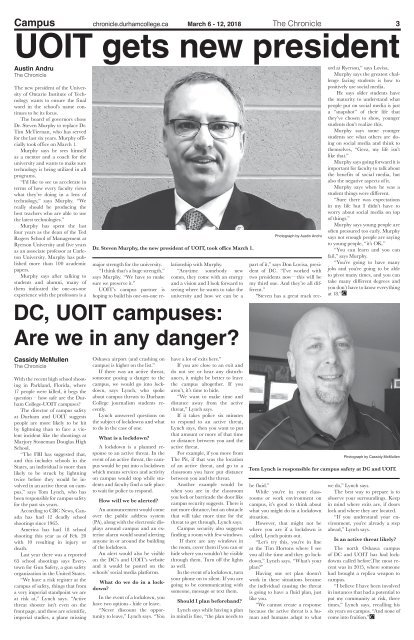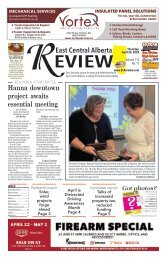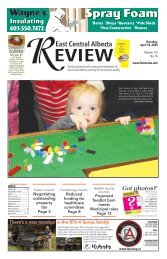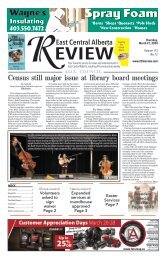You also want an ePaper? Increase the reach of your titles
YUMPU automatically turns print PDFs into web optimized ePapers that Google loves.
Campus chronicle.durhamcollege.ca March 6 - 12, 20<strong>18</strong> The <strong>Chronicle</strong> 3<br />
UOIT gets new president<br />
Austin Andru<br />
The <strong>Chronicle</strong><br />
The new president of the University<br />
of Ontario Institute of Technology<br />
wants to ensure the final<br />
word in the school’s name continues<br />
to be its focus.<br />
The board of governors chose<br />
Dr. Steven Murphy to replace Dr.<br />
Tim McTiernan, who has served<br />
for the last six years. Murphy officially<br />
took office on March 1.<br />
Murphy says he sees himself<br />
as a mentor and a coach for the<br />
university and wants to make sure<br />
technology is being utilized in all<br />
programs.<br />
“I’d like to see us accelerate in<br />
terms of how every faculty views<br />
what they’re doing in a lens of<br />
technology,” says Murphy. “We<br />
really should be producing the<br />
best teachers who are able to use<br />
the latest technologies.”<br />
Murphy has spent the last<br />
four years as the dean of the Ted<br />
Rogers School of Management at<br />
Ryerson University and five years<br />
as an associate professor at Carleton<br />
University. Murphy has published<br />
more than 100 academic<br />
papers.<br />
Murphy says after talking to<br />
students and alumni, many of<br />
them indicated the one-on-one<br />
experience with the professors is a<br />
Dr. Steven Murphy, the new president of UOIT, took office March 1.<br />
major strength for the university.<br />
“I think that’s a huge strength,”<br />
says Murphy. “We have to make<br />
sure we preserve it.”<br />
UOIT’s campus partner is<br />
hoping to build his one-on-one relationship<br />
with Murphy.<br />
“Anytime somebody new<br />
comes, they come with an energy<br />
and a vision and I look forward to<br />
seeing where he wants to take the<br />
university and how we can be a<br />
Photograph by Austin Andru<br />
part of it,” says Don Lovisa, president<br />
of DC. “I’ve worked with<br />
two presidents now—this will be<br />
my third one. And they’re all different.”<br />
"Steven has a great track record<br />
at Ryerson,” says Lovisa.<br />
Murphy says the greatest challenge<br />
facing students is how to<br />
positively use social media.<br />
He says older students have<br />
the maturity to understand what<br />
people put on social media is just<br />
a “snapshot” of their life that<br />
they’ve chosen to show, younger<br />
students don’t realize this.<br />
Murphy says some younger<br />
students see what others are doing<br />
on social media and think to<br />
themselves, “Geez, my life isn’t<br />
like that.”<br />
Murphy says going forward it is<br />
important for faculty to talk about<br />
the benefits of social media, but<br />
also the negative aspects of it.<br />
Murphy says when he was a<br />
student things were different.<br />
“Sure there was expectations<br />
in my life but I didn’t have to<br />
worry about social media on top<br />
of things.”<br />
Murphy says young people are<br />
often pressured too early. Murphy<br />
says not enough people are saying<br />
to young people, “it’s OK.”<br />
“You can learn and you can<br />
fail,” says Murphy.<br />
“You’re going to have many<br />
jobs and you’re going to be able<br />
to pivot many times, and you can<br />
take many different degrees and<br />
you don’t have to know everything<br />
at <strong>18</strong>.”<br />
DC, UOIT campuses:<br />
Are we in any danger?<br />
Cassidy McMullen<br />
The <strong>Chronicle</strong><br />
With the recent high school shooting<br />
in Parkland, Florida, where<br />
<strong>17</strong> people were killed, it begs the<br />
question – how safe are the Durham<br />
College-UOIT campuses?<br />
The director of campus safety<br />
at Durham and UOIT suggests<br />
people are more likely to be hit<br />
by lightning than to face a violent<br />
incident like the shootings at<br />
Marjory Stoneman Douglas High<br />
School.<br />
“The FBI has suggested that,<br />
and this includes schools in the<br />
States, an individual is more than<br />
likely to be struck by lightning<br />
twice before they would be involved<br />
in an active threat on campus,”<br />
says Tom Lynch, who has<br />
been responsible for campus safety<br />
for the past six years.<br />
According to CBC News, Canada<br />
has had 12 deadly school<br />
shootings since 1965.<br />
America has had <strong>18</strong> school<br />
shooting this year as of Feb. 20<br />
with 10 resulting in injury or<br />
death.<br />
Last year there was a reported<br />
65 school shootings says Everytown<br />
for Gun Safety, a gun safety<br />
organization in the United States.<br />
“We have a risk register at the<br />
campus of safety, things that from<br />
a very imperial standpoint we are<br />
at risk at,” Lynch says. “Active<br />
threat shooter isn’t even on the<br />
front page, and these are scientific,<br />
imperial studies, a plane missing<br />
Oshawa airport (and crashing on<br />
campus) is higher on the list.”<br />
If there was an active threat,<br />
someone posing a danger to the<br />
campus, we would go into lockdown,<br />
says Lynch, who spoke<br />
about campus threats to Durham<br />
College journalism students recently.<br />
Lynch answered questions on<br />
the subject of lockdowns and what<br />
to do in the case of one.<br />
What is a lockdown?<br />
A lockdown is a planned response<br />
to an active threat. In the<br />
event of an active threat, the campus<br />
would be put into a lockdown<br />
which means services and activity<br />
on campus would stop while students<br />
and faculty find a safe place<br />
to wait for police to respond.<br />
How will we be alerted?<br />
An announcement would come<br />
over the public address system<br />
(PA), along with the electronic displays<br />
around campus and an exterior<br />
alarm would sound alerting<br />
anyone in or around the building<br />
of the lockdown.<br />
An alert would also be visible<br />
on the DC’s and UOIT’s website<br />
and it would be posted on the<br />
schools’ social media platforms.<br />
What do we do in a lockdown?<br />
In the event of a lockdown, you<br />
have two options - hide or leave.<br />
“Never discount the opportunity<br />
to leave,” Lynch says. “You<br />
have a lot of exits here.”<br />
If you are close to an exit and<br />
do not see or hear any disturbances,<br />
it might be better to leave<br />
the campus altogether. If you<br />
aren’t, it’s time to hide.<br />
“We want to make time and<br />
distance away from the active<br />
threat,” Lynch says.<br />
If it takes police six minutes<br />
to respond to an active threat,<br />
Lynch says, then you want to put<br />
that amount or more of that time<br />
or distance between you and the<br />
active threat.<br />
For example, if you move from<br />
The Pit, if that was the location<br />
of an active threat, and go to a<br />
classroom you have put distance<br />
between you and the threat.<br />
Another example would be<br />
when you are in the classroom<br />
you lock or barricade the door like<br />
campus security suggests. There is<br />
not more distance, but an obstacle<br />
that will take more time for the<br />
threat to get through, Lynch says.<br />
Campus security also suggests<br />
finding a room with few windows.<br />
If there are any windows in<br />
the room, cover them if you can or<br />
hide where you wouldn’t be visible<br />
through them. Turn off the lights<br />
as well.<br />
In the event of a lockdown, turn<br />
your phone on to silent. If you are<br />
going to be communicating with<br />
someone, message or text them.<br />
Should I plan beforehand?<br />
Lynch says while having a plan<br />
in mind is fine, “the plan needs to<br />
be fluid.”<br />
While you’re in your classrooms<br />
or work environment on<br />
campus, it’s good to think about<br />
what you might do in a lockdown<br />
situation.<br />
However, that might not be<br />
where you are if a lockdown is<br />
called, Lynch points out.<br />
“Let’s try this, you’re in line<br />
at the Tim Hortons where I see<br />
you all the time and they go lockdown,”<br />
Lynch says. “What’s your<br />
plan?”<br />
Having one set plan doesn’t<br />
work in these situations because<br />
the individual causing the threat<br />
is going to have a fluid plan, just<br />
like you.<br />
“We cannot create a response<br />
because the active threat is a human<br />
and humans adapt to what<br />
Photograph by Cassidy McMullen<br />
Tom Lynch is responsible for campus safety at DC and UOIT.<br />
we do,” Lynch says.<br />
The best way to prepare is to<br />
observe your surroundings. Keep<br />
in mind where exits are, if doors<br />
lock and where they are located.<br />
“If you understand your environment,<br />
you’re already a step<br />
ahead,” Lynch says.<br />
Is an active threat likely?<br />
The north Oshawa campus<br />
of DC and UOIT has had lockdowns<br />
called before.The most recent<br />
was in 2015, where someone<br />
had brought a replica weapon to<br />
campus.<br />
“I believe I have been involved<br />
in instances that had a potential to<br />
put my community at risk, three<br />
times,” Lynch says, recalling his<br />
six years on campus. “And none of<br />
come into fruition.”


















